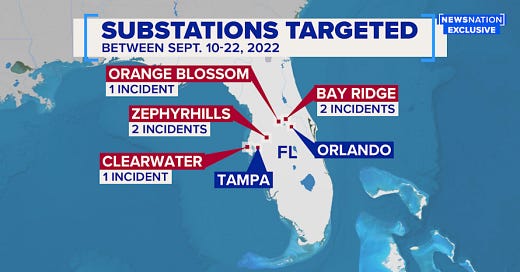Systems Disruption
Let's dive into some recent systems disruption in the US + catch up on the latest action in the battle for Twitter.
There are some early signs of systems disruption.
September 2022: Probes were made against Duke Energy substations in Florida. The nature of the attacks suggested insider knowledge.
November 2022: Six attacks were made on local utility transmission lines and substations in Oregon and Washington. One was made in North Carolina.
December 2022: Two attacks against Duke Energy substations in North Carolina damaged critical equipment, generating an extended outage.
What’s going on?
Years ago, I wrote a book about guerrilla warfare in the age of networks (Brave New War). Based on numerous examples, one of the book's conclusions was that sabotage had become more dangerous in a networked world: it was now systems disruption.
Modern life is utterly reliant on the smooth operation of complex infrastructure.
Due to this infrastructure's complexity, interconnectivity, and tight coupling, even small attacks can cause massive cascades of damage.
This leverage makes it possible for small groups or individuals to easily and safely make small attacks that generate rates of return a million times greater than the cost of the effort.
As costly as this sounds, systems disruption is only a significant crisis if these early attacks incentivize others to do the same thing. When that happens, attacks multiply. With each new disruption, others join, each new attacker with different motivations for joining in — from defeating the government to fighting oppression to making money (it can be profitable), etc. Due to the jumble of motivations involved, finding a way to resolve the situation becomes very difficult as the chaos spreads.
Occasionally, a group or an individual (acting as a vanguard) intentionally tries to ignite this maelstrom. That may be what is going on in this instance. Fortunately, the factors that would allow this likely to happen aren’t present (yet). If those factors appear in the future, I’ll let you know.
NOTE: it’s worth noting that there was a network pattern-matching effort to peg the December attack in North Carolina as a hate crime directed against a local drag show. Given the larger context, that’s unlikely but is a good demonstration of how networks frame events to fit their needs.
Twitter Update
The battle for Twitter keeps rolling on. Here’s a round-up of the online war and how Musk uses Twitter’s interior lines to a significant effect:




